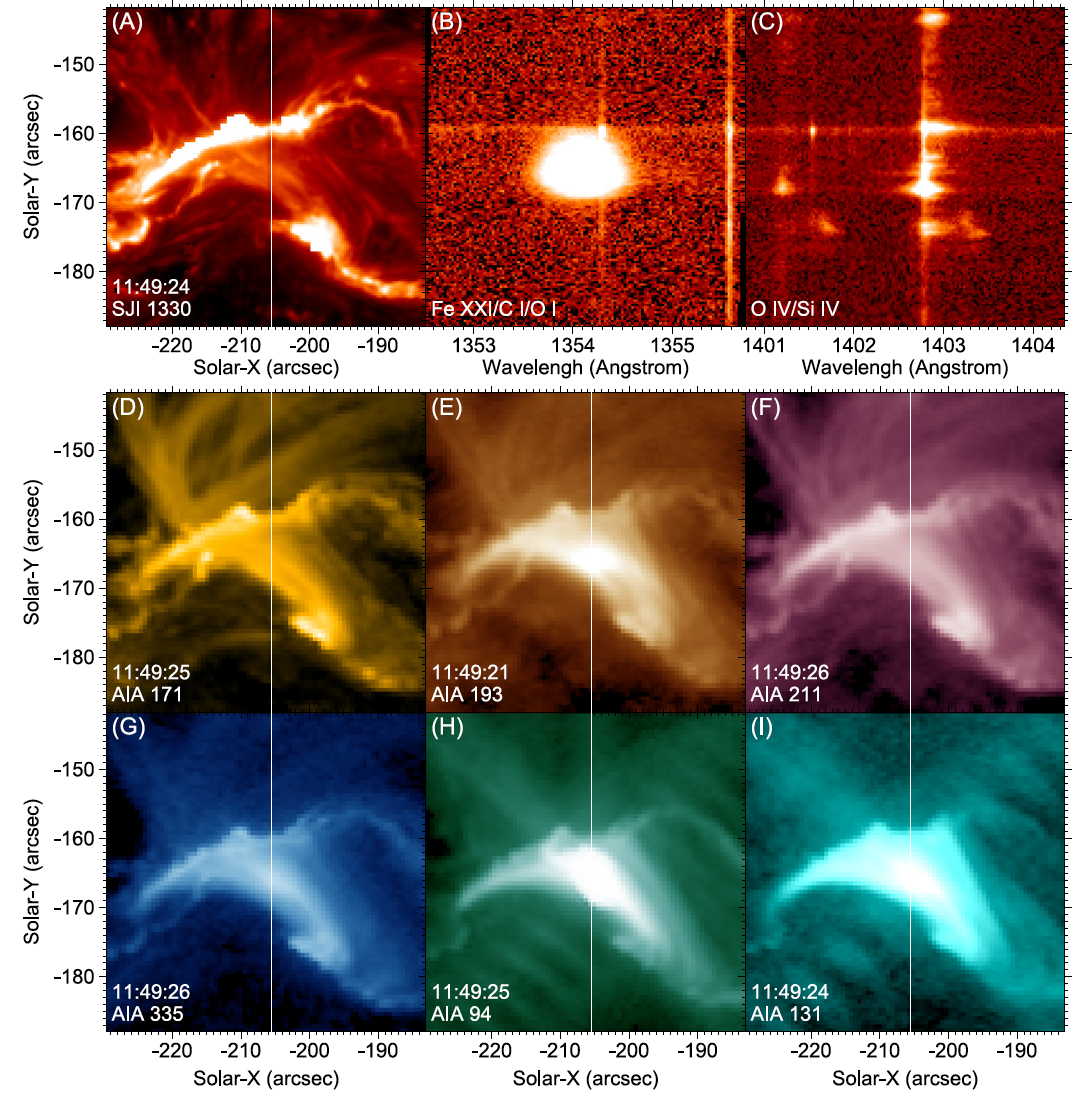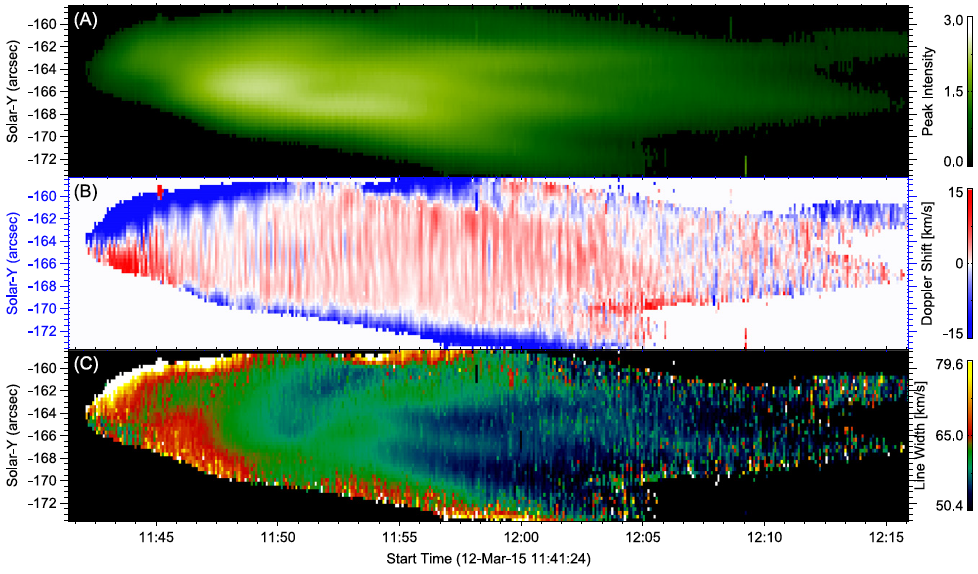众多的卫星和地面观测表明,太阳大气中存在各种磁流体波。学术界普遍认为,这些磁流体波的耗散是太阳大气尤其是日冕加热的一个重要机制。此外,通过结合这些波的观测结果和磁流体力学波动的理论,我们还可以诊断太阳大气中的一些难以直接测量的物理参数,这一研究领域被称为冕震学或磁震学。
腊肠模是太阳大气中几种可能存在的主要磁流体波模之一。它表现为磁流管轴对称的压缩和膨胀,从而导致磁流管的横截面积和密度出现周期性的变化。在日冕中,腊肠快模的相速度与阿尔芬速度相当,大致在1000 km/s的量级。理论研究表明,快腊肠驻波比较容易存在于密度较大且横截面比较宽的磁流管中。在对太阳耀斑的观测中,人们经常在X射线和射电波段的光变曲线中发现周期小于1分钟的震荡信号。长期以来,许多学者将这些短周期的震荡解释为耀斑环中的快腊肠驻波。然而,除了从观测中估算出来的相速度接近预期中的日冕阿尔芬速度外,这些观测通常并没有其它的证据来证实这些周期性的震荡是由快腊肠驻波产生的。另外,也有一些学者将这些周期性信号归功于间歇性磁重联。
通过详细分析太阳界面层成像光谱仪卫星(IRIS)对2015年3月12日的一个M1.6级耀斑的观测数据,我们从光谱学的角度提出了明确的证据,证明此次耀斑中的短周期震荡的确是快腊肠驻波。IRIS卫星在耀斑环中观测到了很强的Fe XXI 1354埃谱线的辐射,表明耀斑环被加热到了1千万度左右的温度。在耀斑环上,Fe XXI谱线的强度和多普勒频移均呈现明显的大约25秒周期的震荡,且二者之间有1/4周期的相差。我们还发现,GOES卫星观测到的全日面积分的软X射线流量呈现出相同周期的震荡,并且与IRIS卫星观测到的多个耀斑环上的Fe XXI 1354强度震荡在时间上具有高度的同步性,这一结果表明所有的耀斑环一起作为一个整体在震荡。震荡从耀斑的脉冲相后期一直持续到衰减相,直至耀斑环中的Fe XXI辐射减弱到无法被IRIS探测到,由于间歇性磁重联主要发生在耀斑的脉冲相,因此这一结果表明我们观测到的震荡最可能是磁流体波。根据观测结果,我们估算出波的相速度约为2420 km/s,与日冕中的阿尔芬速度量级相同。强度与多普勒频移之间1/4周期的相差也与快腊肠驻波的模拟研究相符。根据快腊肠驻波的性质,我们推算出环外的阿尔芬速度应该大于2420 km/s,而环内外的电子密度之比应该大于42。利用SDO/AIA和HINODE/XRT多波段的观测数据,我们估算出了耀斑环中的电子密度,它与环外典型的日冕电子密度之比确实大于42。因此,我们的观测提供了耀斑环中腊肠模振荡的确切证据。我们的工作也是极少数的用紫外光谱来研究耀斑环震荡的工作。
该成果发表在The Astrophysical Journal Letters上(Tian et al. 2016, ApJL, 823, L16)。研究工作得到了“青年千人计划”启动基金和国家自然科学基金委面上项目的支持。论文ADS链接:http://adsabs.harvard.edu/abs/2016ApJ...823L..16T
GLOBAL SAUSAGE OSCILLATION OF SOLAR FLARE LOOPS DETECTED BY THE INTERFACE REGION IMAGING SPECTROGRAPH
Hui Tian1, Peter R. Young2,3, Katharine K. Reeves4, Tongjiang Wang3,5, Patrick Antolin6, Bin Chen7, and Jiansen He1
1 School of Earth and Space Sciences, Peking University, Beijing 100871, China; huitian@pku.edu.cn
2 College of Science, George Mason University, Fairfax, VA 22030, USA
3 NASA Goddard Space Flight Center, Code 671, Greenbelt, MD 20771, USA
4 Harvard-Smithsonian Center for Astrophysics, 60 Garden Street, Cambridge, MA 02138, USA
5 Catholic University of America, Washington, DC 20064, USA
6 National Astronomical Observatory of Japan, Osawa, Mitaka, Tokyo 181-8588, Japan
7 Department of Physics, New Jersey Institute of Technology, Newark, NJ 07102, USA
ABSTRACT
An observation from the Interface Region Imaging Spectrograph reveals coherent oscillations in the loops of an M1.6 flare on 2015 March 12. Both the intensity and Doppler shift of Fe XXI 1354.08 Å show clear oscillations with a period of ∼25 s. Remarkably similar oscillations were also detected in the soft X-ray flux recorded by the Geostationary Operational Environmental Satellites (GOES). With an estimated phase speed of ∼2420 km/s and a derived electron density of at least 5.4 x1010 cm−3 , the observed short-period oscillation is most likely the global fast sausage mode of a hot flare loop. We find a phase shift of ∼π/ 2 (1/ 4 period) between the Doppler shift oscillation and the intensity/GOES oscillations, which is consistent with a recent forward modeling study of the sausage mode. The observed oscillation requires a density contrast between the flare loop and coronal background of a factor >42. The estimated phase speed of the global mode provides a lower limit of the Alfvén speed outside the flare loop. We also find an increase of the oscillation period, which might be caused by the separation of the loop footpoints with time.



